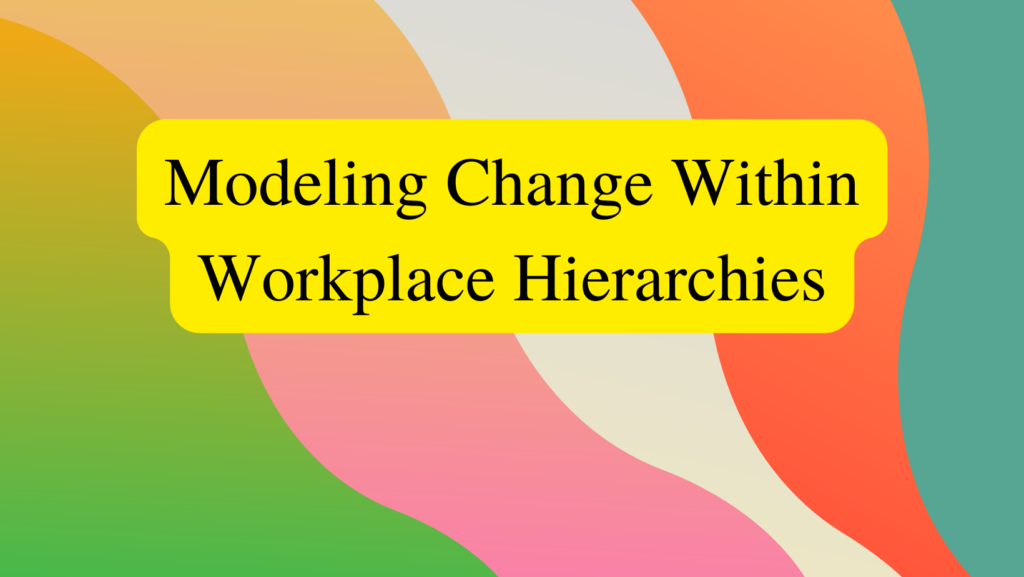
“I have struggled with my own lineage, especially in relationship to the work that needs to be done to confront racism, sexism, patriarchy, ableism, whiteness, and all the various invitations to spiritual bypass. My takeaway from this rather painful struggle has been this: we cannot wait for lineage elders to institute the changes we want — we need to step up and lead.”
-Justin Von Bujdoss (Our Traditions Can—and Must—Change, Buddhadharma, Winter 2020)
The insight above came from an American Vajrayana teacher’s wrestling with Buddhist traditions and hierarchies, and it contains lessons for those change management leaders who believe modeling change can and should occur at all levels of the organizational chart.
Modeling change: the struggle
First, it’s important to struggle with the dynamics of hierarchy — your own positioning and that of others. This means honestly assessing your three Ps:
- Power
- Position
- Privilege
Power and position in the hierarchy are often erroneously made synonymous. While there is certainly some overlap, power refers to the ability to persuade — and this isn’t always tied directly to position. Change management research, for example, continues to point to the power dynamics of informal organizational networks (for more on that, see this classic article by David Krackhardt at Harvard Business Review). In other words: the head of sales may not be the primary influencer on the sales team.
Here are a few key questions change leaders should ask themselves as they work to understand their power:
- Who do I have positional authority over, how do I use this, and how would I rank their ability to influence myself and others?
- What does my ability to persuade look like on a regular basis? What specific examples can I provide to show this?
- What strong workplace relationships do I have, formally and informally?
These questions, coupled with mindfulness-based practices to more fully understand the relationship nuances they may bring forth, can help change managers have a more realistic (and less biased) look at their environment and the roles they play within it.
Privilege is undoubtedly far less understood than both power and positioning in the workplace. Again, there’s overlap between these, but without intensive inner work, managers of change will not have the rich understanding of privilege they need to lead across change.
Change management practitioners of the past primarily led short-term change projects — more anaerobic change initiatives that happened in short bursts to reach a desired state of operating. Such bursts relied on relationship-building, of course, but they relied far more on top-down power and positioning.
Today, important change initiatives still happen in rather intense anaerobic bursts — an enterprise migrating on-premises assets to the cloud, for example — but modern organizations increasingly understand that change management must be an embedded and continuous discipline and process throughout the company.
This places greater emphasis on relationship and trust-building, and for today’s change agents this requires unpacking privilege — from understanding how white privilege manifests and exhibits itself in the external environment, for example, to creating the psychologically safe spaces for all colleagues to bring their whole selves to work.
As you can see, this involves both the inner contemplative work of mindfulness and the cross-departmental practical strategizing necessary to build, engage, and bring out the best of an inclusive workforce. Note: the diversity intelligence work of Dr. Claretha Hughes is particularly interesting in this regard, especially as it relates to assessing baseline levels of “intelligence” around issues of diversity.
I’d also recommend building out an ongoing personal strategy for understanding privilege. As an entry point, fellow Buddhists may find value in the following resources on racism:
There are also a variety of other fantastic resources and opportunities, including:
Modeling change: the humility
The struggle we are discussing here naturally cultivates humility — the more you understand the multifaceted flavors of your power and the power of others, the more you’ll want to wield power mindfully.
However, it can be easy to be so steeped in humility that you succumb to analysis paralysis because you are too scared to act for fear of unintentionally causing harm to others. Get this straight: you will make mistakes and those mistakes, if properly metabolized, will be tremendous opportunities for you to grow into a better manager of change.
The humility you cultivate should be paired with a bias towards action. “We cannot wait,” as Justin Von Bujdoss wrote, by holding onto a perhaps false sense of hope that those with more positional authority will bring forth the change.
The insight of a single leader can spark change, but no matter which change management framework you may (or may not) be working with, change will likely be far messier and more collaborative than you initially imagined.
Do the inner work, build a continuous contemplative practice, perhaps post some quotes on change around your workstation as reminders and, lastly, heed the wisdom offered in a translated sermon (see Food for the Heart) from Ajahn Chah:
“In truth it’s all uncertain, but our desires want things to be certain. What can we do? We must be patient. The most important thing is khanti, patient endurance. Sometimes I’d go to see old religious sites with ancient monastic buildings, designed by architects, built by craftsmen. In some places they would be cracked. Maybe one of my friends would remark, ‘Such a shame, isn’t it? It’s cracked.’ I’d answer, ‘If that weren’t the case then there’d be no such thing as the Buddha, there’d be no Dhamma. It’s cracked like this because it’s perfectly in line with the Buddha’s teaching.’”
With this approach and with these beliefs kept close, you’ll be not only able to lead change but also able to change across change — a critical skill needed by today’s change management leaders.
Continued Learning
- Understand how to embody the planned change in a change management initiative
- Watch this video on defining feedback